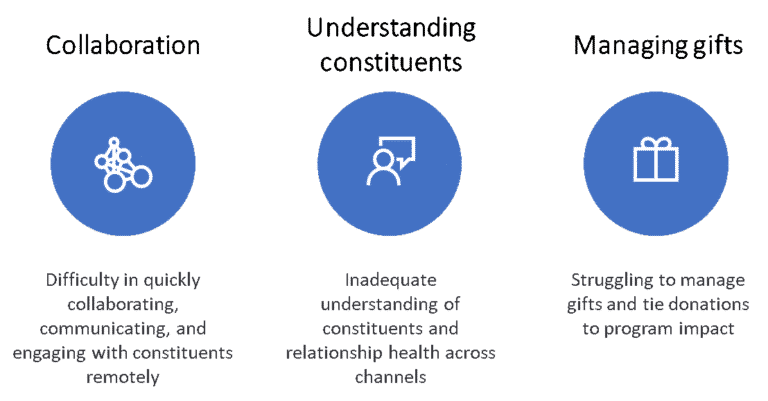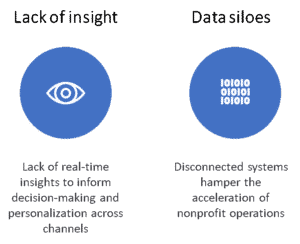

To design a digital fundraising campaign, you must first take stock of the current challenges facing your Non-Profit organization.
As donor expectations change, the vision for Non-Profits extends from donor engagement to program impact reporting. Program impact reporting is a measurement framework that aggregates qualitative and quantitative program data to measure the success of your program goals. Different Non-Profits are at varying levels of maturity. The more agile processes you adopt, the faster the rate of growth in terms of fundraising, marketing, programs, services and operations to better serve their communities.
Let’s look at some of the common challenges that Non-Profit organizations face:


You may be facing some or all of these challenges. Once you have identified the challenges you may have previously experienced in digital fundraising campaigns, you can then brainstorm to fill the gaps and determine how those gaps will impact your fundraising campaign.
Changing donor expectations are also leading Non-Profits to reimagine their processes to meet those expectations. They are embracing digital technology in all areas of the organization but especially in fundraising and engagement to:
- Identify donors and build a committed pipeline of prospects and donors
- Act and engage on a 360-degree view of donors and constituents
- Personalize engagement across channels
- Maintain and deepen constituent relationships
- Increase the donor lifetime value
Here are some things to keep in mind in the planning and execution of a successful fundraising campaign:
1. Attract, retain, and grow donors through personalized engagement
There are many ways technology can help you sustain and grow your organization. It can help you:
- Gain a more in-depth understanding of your supporters that you can use to direct targeted communications.
- Increase donor loyalty and lifetime giving by understanding and addressing funder priorities.
- Improve prospect identification by identifying potential major givers early in the relationship.
- Deliver personalized engagement plans, funding opportunities, and transparent impact reporting.
- Enhance your ability to respond quickly to rapidly shifting organizational and program needs.
You can determine the success of these measures through KPIs such as:
- Increased number of donors
- Increased donor pipeline
- Increased donor retention rate
- Increased number and size of donations received
- The increased lifetime value of constituents
- Increased propensity to give
Are you interested in a crash course in fundraising and engagement? Download this free ebook to find out the six ways to be a great fundraiser during challenging times.
2. Drive fundraising efficiency and reduce costs with automated processes
One of the best ways to maximize the value of each donated dollar is to increase internal efficiencies and reduce costs.
You can achieve this by:
- Eliminating functional siloes by unifying fundraising and marketing data and connecting business processes. By doing so, you can manage giving prospects more effectively across the entire constituent journey.
- Automating routine, repetitive tasks to free up staff time and increase the constituent lifetime value.
- Automating business processes that are currently done manually, such as:
- Processing recurring gifts and donor commitments
- Membership renewals
- Receipt creation
- Routing and escalating constituent requests
- Jointly planning complex constituent journeys to:
- Effectively target prospective, recurring, and major gift donors
- Attract new constituents
- Increase the number of recurring donors
You can determine the success of these measures through KPIs such as:
- Reduced operating costs
- Increased fundraising ROI
- Better staff time utilization
- Reduced collection time for pledges and recurring donations
3. Get an accurate, real-time view of fundraising and financial outcomes
More and more Non-Profits are looking for immediate financial and fundraising results without waiting until the end of each month.
With Fundraising and Engagement built for Dynamics 365 Sales Enterprise for Non-Profits, you can get an accurate, real-time view of fundraising and financial outcomes through a system that:
- Aggregate’s revenue and expense transactions to provide greater visibility into program sustainability and financial transparency.
- Eliminates the need for complex fundraising and financial reconciliation through end-to-end donation revenue and transaction management.
- Provides fundraisers and financial managers with a common donation, revenue, and transaction management and data schema.
You can determine the success of these measures through KPIs such as:
- Timely financial reconciliation
- Real-time operating cash flow and working capital
- Increased fundraising and program delivery ROI
- Reduced cost per service provided
- The ratio of funds spent on admin versus program delivery
- Measurement of impact/outcomes per dollar spent
4. Align all Non-Profit systems and applications on a single platform
Dynamics 365 and all of Microsoft’s Non-Profit innovation is a purpose-built platform that aligns fundraising, program delivery, finance, and operations with actionable insights. The impact is an ideal way to meet growing donor expectations for seeing the impact of their donations.
This makes it easier for Non-Profits to:
- Gain immediate insight into fundraising, finance, and program metrics
- Correlate program service delivery to financial data to let donors and grant makers know how each dollar is driving a specific outcome.
- Control risk by managing fraud and protecting digital revenue.
You can calculate the benefit with KPIs such as:
- Reduced IT costs
- Better integrated data and systems
- Improved impact reporting
- The ability to track funding sources to program outcomes and measure impact/outcomes per dollar spent
- Reduced time spent on monitoring and evaluation
- An improved ratio of funding spent on programming versus overhead
5. Understand the psychology of giving to craft a winning fundraising communications strategy
Before finding out why people donate money to charity, did you know the number one reason why donors stop giving?
They do not know how their gift is being used! Thus, transparent impact reporting is crucial to your fundraising success.
Some of the reasons why people donate are because they feel a sense of gratitude for what they have and thus have a sense of moral responsibility to give back to those in need. Other reasons include their personal beliefs and values or life-changing experiences, and religious values.
If you would like to educate and encourage new potential donors, perhaps this article by Canada Helps on ‘5 Reasons Why You Should Donate to Charity’ will provide you with some insights on your fundraising communication strategy.
Bear in mind that your fundraising campaign messaging will need to be tailored depending on your donor profile and the channel (Email or social media platform, or website) where you will be publishing content.
6. Build your fundraising campaign on a compelling campaign idea
Remember the ice bucket challenge (aka ALS ice bucket challenge) that had gone viral on social media? ALS is a rare neurological disease. The ALS Association is the largest private funder of ALS research in the world. In 2014, the ice bucket challenge had raised over $220M worldwide for the disease! The point we are trying to make is to get creative. Brainstorm with your team and come up with a compelling central theme for your fundraiser. Your campaign idea must be unique and engaging. Hosting just another bake sale is not enough. Focus on sustained efforts so that your donors keep coming back to you year after year. A running shoe drive fundraiser is one such example. You can learn more about hosting a successful running shoe drive fundraiser here: a step-by-step guide by Sneakers4Funds.
7. Some tactical steps you will need to take to execute a digital fundraising campaign:
- Create a branded and SEO-compliant landing page for your fundraiser
- Chalk out a social media calendar and messaging across platforms
- Build digital assets to use in your marketing communication across digital platforms (website, social, website, etc.)
- Build a segmented email list
- Develop a calendar/workflow of personalized email campaigns
- Invest in a peer-to-peer fundraising platform
- Track and monitor the progress
Are you looking to revamp your digital tools to scale your mission impact? Consider GiveLife365 as a potential match. Check out these Microsoft customer stories to find out how Non-Profit customers have found value in GiveLife365.
Here’s a tip before you go. Diversify your funding sources. Do not restrict yourself to domestic funding. Add in funding sources, including institutional funding, CSR funding, and grants from HNIs and philanthropists in your digital fundraising strategy.
